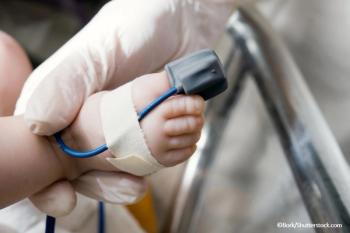
HIV Infection: Clues to Timely Diagnosis
Early diagnosis enables patients to derive maximum benefit from highly active antiretroviral therapy (HAART). Primary care practitioners can play a key role in the timely identification of HIV infection.
The number of patients admitted to the hospital with unrecognized HIV infection in the United States remains high.1 Despite efforts to increase HIV testing among at-risk populations, most infections are identified late in the disease when patients present with significant immune suppression and HIV-associated illness.
Early diagnosis enables patients to derive maximum benefit from highly active antiretroviral therapy (HAART). Primary care practitioners can play a key role in the timely identification of HIV infection.
In this article, we discuss the manifestations of both acute and chronic HIV infection and describe clues that point to the diagnosis. We also review the latest testing protocols for patients with risk factors, pregnant women, and patients in whom an established infection is suspected. Additional resources that can be helpful to clinicians who lack specialized training are listed in the Box.
EPIDEMIOLOGY
Since the introduction of HAART in the mid-1990s, HIV-associated morbidity and mortality have significantly declined.2 The epidemic has stabilized over the past few years in the United States, thanks to public health interventions that target risk reduction and increased HIV testing.
However, certain sectors of the population continue to be disproportionately affected. African Americans accounted for 50% of all HIV/AIDS cases diagnosed in 2003. Although men account for the majority of infections, women represent the fastest growing population of persons with HIV/AIDS.2 Women are more likely to be infected through heterosexual contact and are often unaware of their male partners' risk factors for HIV infection (eg, unprotected sex with multiple partners, sex with men, or injection drug use).3
RISK ASSESSMENT
Routine risk assessment and testing in the clinical setting present opportunities to monitor high-prevalence communities more closely, perform risk-reduction counseling, and destigmatize HIV testing.4 Conduct an HIV risk assessment with every new patient and regularly with all patients, regardless of their symptoms.
Begin a sexual risk assessment with an assurance of confidentiality and an explanation of why these questions are important. In the sexual history, focus on specific sexual behaviors (ie, "vaginal intercourse") rather than a person's sexual orientation (ie, "straight" or "gay"). Ask about frequency of condom use. Elicit any history of injection drug use--specifically, needle sharing. In addition, question the patient about past tattoos, blood transfusions, and needle sticks and other occupational hazards.5
If one or more risk factors for HIV infection are identified (Table 1) or if the patient is pregnant, HIV testing is indicated. The CDC is expected to release new guidelines this summer that will recommend HIV screening for all patients between the ages of 13 and 64 years, even in the absence of risk factors.
Providers who offer HIV testing need to be familiar with pretest and post-test counseling services and with the "opt-out" informed consent protocol. In opt-out consents, patients are offered HIV testing as part of routine laboratory screening.
Pretest counseling includes education about HIV/AIDS, the HIV testing process, the meaning of positive and negative test results, modes of transmission, and prevention.
Post-test counseling usually begins with a review of the patient's understanding of positive and negative test results. When a result is negative, emphasize that it may not reflect HIV acquisition during the 3 months immediately preceding the test (the "window period"). If a result is positive, it is important to provide emotional support while giving honest and factual information. Be aware of appropriate community organizations, social agencies, peer support groups, and other resources to which you can refer patients who need additional counseling for emotional distress, peer support, or other services.
Counseling and testing can lead to changes in high-risk sexual and drug-use behavior. Most important, they lead to earlier diagnoses, which allow infected persons to seek treatment with HAART, prophylaxis against opportunistic infections, and vaccines that prevent life-threatening infections associated with HIV infection. Prevention counseling among HIV-infected persons may encourage safer behaviors, thereby decreasing HIV transmission to others.
CASE 1: CLINICAL MANIFESTATIONS OF ACUTE HIV INFECTION
A 37-year-old previously healthy man presents with a 2-day history of fever, sore throat, swollen lymph nodes, severe fatigue, and a rash. Results of previous HIV antibody tests have been negative. A sexual history reveals that he had unprotected anal-receptive intercourse with a male partner 2 weeks earlier. Physical examination reveals a temperature of 39.0°C (102.2°F), non-exudative pharyngitis, cervical and axillary lymphadenopathy, and a generalized maculopapular rash.
What clues here point to acute HIV infection?
The onset of symptoms of acute HIV infection typically occurs between 1 and 8 weeks after exposure. As in the man in Case 1, the symptoms most often occur during the second week.
Acute HIV infection can mimic many other viral infections (such as mononucleosis and influenza). Like this patient, up to 80% of persons newly infected with HIV report a history of a viral syndrome, the most common symptoms of which include fever, fatigue, myalgia, rash, headache, lymphadenopathy, and pharyngitis (Table 2).6 The constellation of signs and symptoms may be extremely mild--or they can be so debilitating that hospitalization is required.
CASE 2: WORKUP OF SUSPECTED ACUTE HIV INFECTION
A 17-year-old boy presents with a 4-day history of fever, sore throat, vomiting, diarrhea, nonproductive cough, and fatigue. He reports a history of unprotected intercourse with 6 girls during the past 3 years. The last sexual exposure was 3 weeks earlier. Physical examination reveals fever, exudative pharyngitis, and shotty cervical lymphadenopathy.
What would you include in the workup for this patient?
In patients such as the boy in Case 2, in whom the risk assessment and clinical manifestations both suggest acute HIV infection, laboratory studies are indicated to make the diagnosis (Table 3). Two tests are useful in the diagnosis of acute HIV infection:
- An HIV antibody test.
- An HIV viral test.
The preferred HIV viral test is the HIV RNA test. The HIV RNA test is most commonly used to follow the progress of patients with chronic HIV infection. However, in the early phases of acute HIV infection (ie, the first 1 to 3 months), the HIV virus multiplies rapidly and HIV RNA is high before HIV antibodies are detectable.
Thus, the results that confirm acute HIV infection are:
- A negative result on an HIV antibody test together with
- A positive result on an HIV viral test.
HIV antibody test results will become positive in 50% of newly infected patients within 30 days, in 90% of patients within 90 days, and in 99.9% of patients within 6 months.
CASE 3: CLINICAL MANIFESTATIONS OF CHRONIC HIV INFECTION
A 46-year-old woman presents with a history of 7 days of productive yellow-green sputum and subjective fevers, chills, and nocturnal sweats. She complains of right-sided, pleuritic chest pain, dyspnea, and myalgia. Her chart shows that she has lost 60 lb during the past 6 months.
What clues here point to chronic HIV infection?
Once HIV infection has been established, most patients enter a latent phase during which the CD4+ cell count and HIV viral load remain generally stable (Figure 1).7 During this period, which may last for many years, patients are most often asymptomatic, although some may experience fatigue, low-grade fevers, or lymphadenopathy. Without antiretroviral therapy, the CD4+ cell count will eventually drop, and symptoms of immune dysfunction will begin to appear. Usually, patients do not present with HIV-associated illness until this later stage, when the overt signs and symptoms of chronic HIV infection and the symptoms of specific opportunistic infections appear.
Most signs and symptoms associated with later-stage chronic HIV infection are long-term and systemic and can resemble those of cancer and other chronic illnesses. Patients with moderate to severe immunocompromise typically present with wasting, fatigue, sweats, decreased appetite and, in children, failure to thrive. Lymphadenopathy and recurrent oral lesions are common. Oral lesions can include herpes simplex virus infection, candidal infection (thrush) (Figure 2), warts, aphthous ulcers, and gingivitis (Figure 3).
GI and genitourinary manifestations include generalized abdominal tenderness, recurrent vaginitis, genital herpes, and anal warts. A neurologic examination may elicit signs of peripheral neuropathy and, in some advanced cases, memory loss. The common dermatologic findings are folliculitis, herpes zoster, herpetic lesions, molluscum contagiosum (Figure 4), seborrheic dermatitis (Figure 5), and Kaposi sarcoma. Common laboratory findings include thrombocytopenia, leukopenia, and elevated hepatic enzyme levels.
CASE 4: WORKUP OF SUSPECTED CHRONIC HIV INFECTION
A 3-year-old adopted girl presents with a 6-month history of persistent fever, recurrent infections, and failure to thrive.
What would you include in the workup for this patient?
HIV antibody testing is usually a multistep process: a positive result on a screening enzyme-linked immunosorbent assay (ELISA) must be repeated on the same sample, and at least 2 of 3 results must be reactive before the laboratory proceeds to verification with confirmatory assays.8
The most widely used confirmatory antibody assay is the Western blot; most authorities consider it the "gold standard" for validation of HIV test results, and it is necessary for definitive diagnosis. Occasionally, results of Western blot tests may be reported as "indeterminate." Such results may represent early seroconversion; consultation with an HIV expert is advised.
Other diagnostic tests include the rapid HIV antibody test, which is used as an initial screening test, and the indirect immunofluorescence assay (IFA), which is used as a confirmatory test.
Rapid assays, defined as tests that can be performed in less than 30 minutes, are gaining in popularity as an initial HIV screening test because they facilitate immediate intervention in the event of a positive result. The new generation of rapid HIV tests are extremely sensitive and specific (approximately 99.8% on both counts) and perform at least as well as the ELISA.
The IFA performs similarly to the Western blot. However, it is more expensive than the latter and not commonly used.
References:
REFERENCES:1. Centers for Disease Control and Prevention. Recommendations for HIV testing services for inpatients and outpatients in acute-care hospital settings. MMWR. 1993;42(RR-2):1-6.
2. Centers for Disease Control and Prevention. HIV/AIDS Surveillance Report, 2003. Vol 15. Atlanta: US Dept of Health and Human Services, Centers for Disease Control and Prevention; 2004:1-46. Available at: http://www.cdc.gov/hiv/topics/ surveillance/resources/reports/index.htm. Accessed May 17, 2006.
3. Hader S, Smith DK, Moore JS, Holmberg SD. HIV infection in women in the United States: status at the millennium. JAMA. 2001;285:1186-1192.
4. Centers for Disease Control and Prevention. Revised guidelines for HIV counseling, testing, and referral. MMWR. 2001;50(RR-19):1-58.
5. Mountain Plains AETC; Department of Medicine, Division of Infectious Diseases, University of Colorado Health Science Center, Denver. HIV Risk Assessment: A Quick Reference Guide. Available at: http://www.mpaetc.org/scripts/prodList.asp. Accessed June 6, 2006.
6. Sande MA, Volberding PA. The Medical Management of AIDS. 6th ed. Philadelphia: WB Saunders; 1999.
7. Pantaleo G, Graziosi C, Fauci AS. New concepts in the immunopathogenesis of HIV infection. N Engl J Med. 1993;328:327-335.
8. Constantine N. HIV antibody assays. HIV InSite Knowledge Base. Available at: http://hivinsite.ucsf/ InSite?page=kb-02-02-01. Accessed May 17, 2006.
Evidence-based medicine:
- Boyer CB, Barrett DC, Peterman TA, Bolan G. Sexually transmitted disease (STD) and HIV risk in heterosexual adults attending a public STD clinic: evaluation of a randomized controlled behavioral risk-reduction intervention trial. AIDS. 1997;11: 359-367.
- DiClemente RJ, Wingood GM, Harrington KF, et al. Efficacy of an HIV prevention intervention for African American adolescent girls: a randomized controlled trial. JAMA. 2004;292:171-179.
Guidelines:
- CDC Guidelines for HIV Counseling, Testing, and Referral (November 9, 2001). Available at:
http://www.AIDSinfo.nih.gov .
- Public Health Service Task Force Recommendations for the Use of Antiretroviral Drugs in Pregnant HIV-1 Infected Women for Maternal Health and Interventions to Reduce Perinatal HIV-1 Transmission in the United States (November 17, 2005). Available at:
http://www.AIDSinfo.nih.gov .
Newsletter
Enhance your clinical practice with the Patient Care newsletter, offering the latest evidence-based guidelines, diagnostic insights, and treatment strategies for primary care physicians.





















































































































































































































































































